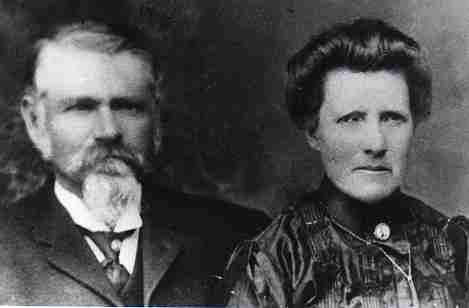Dr. George Washington Hickman and his wife Lucy Ann Haws Hickman
Picture was provided by Lynn Richardson of Benjamin, Utah
--o0o--
COUNTRY DOCTOR
by Zina Hickman
Dr. George W. Hickman was one of the first doctors to settle in Utah county. He was born March 12, 1825, in Randolph County, Miss., of Edwin Temple Hickman and Elizabeth Adams. His early education was had by tutoring by his parents who were fairly well educated, and in public schools. Later he attended Oberlin College, Ohio, from which institution he obtained his medical degree.
Armed with his certificate to practice medicine, young Doctor Hickman set out for the far reaches of California, but he was destined never to reach that state, for Johnston's army was at that time also headed westward, and the two met just outside the state. The young doctor was suspected of being a Mormon spy and was taken into custody. He was rescued by his brother, W. A. Hickman, a Mormon scout who discovered his plight, brought him into Utah and converted him to the church. He thereafter remained in Utah a faithful Latter-day Saint for the remainder of his life.
Dr. Hickman settled in Utah County where he met and married Lucy Ann Hawes, The ceremony was solemnized on Christmas Day, 1858, at Salem and the young couple settled on a pre-empted ranch in the vicinity <p.211> of Payson, the locality now known as Benjamin. Here Dr. Hickman began his practice of medicine.over a territory covering a radius of fifty miles. At that time there was only one other doctor of medicine in Utah county. This was Dr. Pyke, father of the well-known Utah author, Annie Pyke Greenwood, who settled in Provo. The two doctors were not rivals as each had all he could do within his own territory.
However, Dr. Hickman did not continue the practice of medicine as a full time profession for long. A conference with President Brigham Young gave him to understand that the people needed to exercise their faith in healings by the priesthood instead of running to the doctor for every ailment. The following taken from the journal of Josephine Hickman Finlayson, eldest daughter of the doctor, relates the situation:
"President Young counseled father not to practice medicine because he wanted to teach the people faith and dependence upon God, 'for by their faith they should be healed.' This was a stunning blow to a young man who had spent years in preparation for a profession suddenly to have his staff knocked from under him. No one was ever less fitted for the role of frontiersman and rancher than he. He knew nothing of the agricultural life which was the only one to choose. Gradually, however, he was drawn back into giving medical service but he seldom charged a fee, and when he did, he often allowed the people to set the price and time of payment which seldom came. Let me here state, my father never regretted joining the L.D.S. church, and ever rejoiced in its glorious principles and its divinely inspired leaders."
This same daughter often accompanied her father, in the absence of nurses, to assist with broken bones and other emergencies. One emergency which drew the doctor back into practice was an epidemic of diphtheria which struck at almost every family in the vicinity. Dr. Hickman always enlisted the prayers of the elders along with his skill and the contents of his little black bag. Copper-sulphate (blue-vitriol) was his old stand-by for swabbing throats and noses. He always said it was the power of the Lord that saved the people, he was only an instrument in His hands.
Dr. Hickman's family remember well many of their father's treatments for various illnesses, also the fact that he always made his own splints for broken bones. Podophyllin, a bitter purgative resin extracted from the May Apple root stock, was a popular laxative of the time. Blood-letting was also indulged in by the physicians of that day when a tourniquet was fastened around the arm and a quantity of blood drawn off. Dr. Hickman recognized that the pressure of the blood, in some cases was too high, and relieved this abnormalcy by drawing off blood.
It is most interesting to note from Mrs. Finlayson's diary the great versitality of her mother in supplementing the family income during all the years when her husband obeyed council not to practice his profession.
She it was who directed the farming, with her sons to do the work. She made cheese, built her own chicken coops, made buckskin gloves which she sold, and which were in great demand, made straw hats, wove and spun her own cloth, as well as engaged in the many other activities of pioneer women of that time. She was indeed left desolate by the death of Doctor Hickman, who died of pneumonia, Nov. 24, 1893.
--Kate B. Carter, ed., Heart Throbs of the West, Daughters
of Utah Pioneers, 1946, Vol. 7, pp. 210-211
To learn more about George W. Hickman and his family, click here or here.
To learn more about his activities in the Utah War, click here.
To return to the Hickman Family index page, click here.

